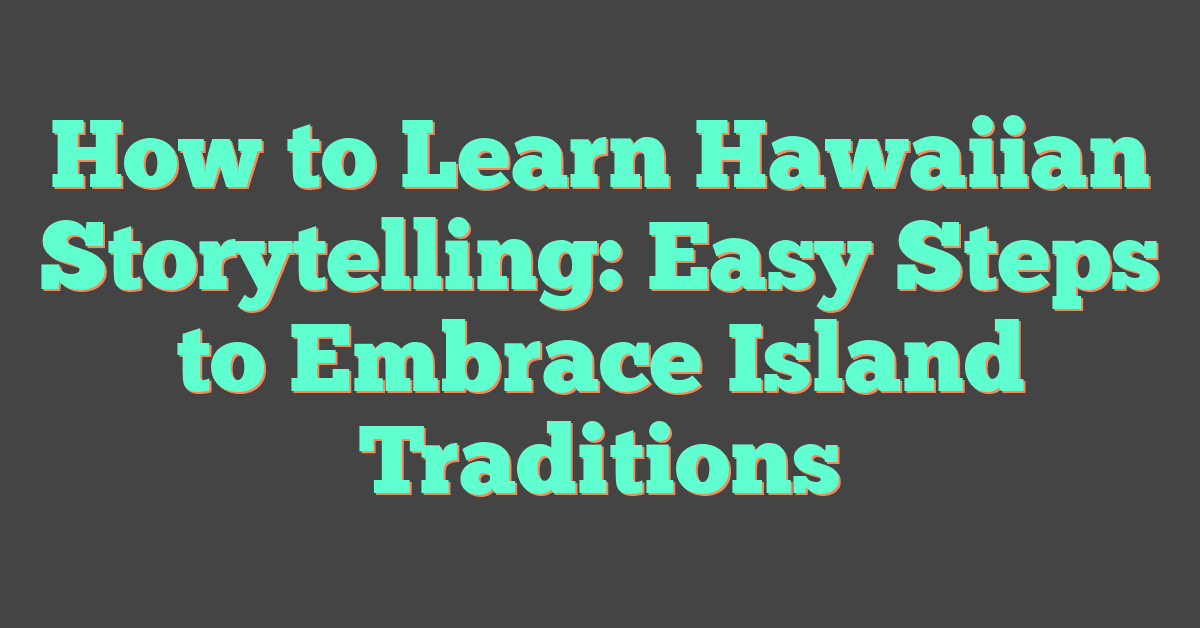When I first became interested in Hawaiian culture, I felt amazed by how important storytelling is to native Hawaiian life.

Traditional Hawaiian storytelling, called moʻolelo, is more than just sharing tales. It keeps history, traditions, and values alive for future generations.
To learn Hawaiian storytelling, I study the language, understand oral traditions, and connect with community elders. These steps help me grow in the art of storytelling.

Hawaiian stories blend chant (oli), songs (mele), and spoken word.
Learning basic Hawaiian phrases like “aloha” and “mahalo” helps me show respect for the culture and connect more deeply with the stories.
If you’re curious about how to start, learning the basics and seeking out local guides can open up a world of wisdom and tradition. Articles about Hawaiian oral storytelling and cultural traditions give great starting points.
Even if you don’t speak the language fluently, exploring these stories lets you experience the heart of Hawaii.
Understanding Hawaiian Storytelling
Hawaiian storytelling goes beyond sharing tales. It helps me connect with traditions and honor my ancestors.
I use storytelling to keep our cultural heritage alive.
Cultural Significance of Storytelling
Storytelling is a key part of Hawaiian culture. It shapes morals, values, and social rules in our community.
Through these stories, I learn about the land, the sea, and the spirits that guide us.
Storytelling links generations by passing on language, beliefs, and important teachings.
When I share a moʻolelo (story), I take part in a tradition that keeps our culture strong and respected.
This practice builds respect and understanding, especially when I tell stories with the true Hawaiian spirit.
Every time I “talk story,” I help preserve the heart of who we are as Native Hawaiians.
Role of Oral Tradition
People have passed down most Hawaiian stories by word of mouth, not in books.
Oral tradition helps me remember and retell legends, genealogy, and history.
Listening carefully to elders is important. They teach me not just words but the right ways to pronounce Hawaiian, which shows respect for the language.
Mastering sounds like the ʻokina and elongated vowels helps me share stories more accurately, as shown in learning the art of traditional Hawaiian storytelling.
Today, I also see storytelling in digital media, music, and film. New generations connect with their cultural heritage in modern ways.
Ancestral Wisdom and Knowledge
Storytelling lets me carry the wisdom of my ancestors forward.
Lessons about living with the land and sea, respecting ohana (family), and understanding natural cycles all come from these stories.
Each tale offers practical advice. Some stories explain how to farm or fish, while others teach about kindness, bravery, or balance in life.
By sharing moʻolelo, I learn from my ancestors’ successes and challenges.
Through storytelling, I gain a deeper sense of belonging and responsibility.
Exploring Moʻolelo and Myths
Hawaiian storytelling blends moʻolelo (stories), legends, and ancient traditions.
These tales help me see the world through the eyes of those who came before.
They help me understand the beliefs, values, and important characters in Hawaiian culture.
Legends and Creation Stories
Moʻolelo include myths and legends that explain how the Hawaiian Islands and its people came to be.
One of the most important is the Kumulipo, an epic chant and genealogy that tells the story of creation. It describes how the world formed from darkness to light and connects Hawaiian families to ancient gods.
These stories teach me about the deep link between the land, people, and spirits.
The Menehune are legendary “little people” believed to have built sites like the Menehune Fishpond on Kauaʻi. Local stories often connect real places with legendary events.
Gods and Goddesses
Hawaiian myths feature gods and goddesses, each with their own powers and stories.
Some main figures include Pele, the goddess of fire and volcanoes, and Kanaloa, the god of the ocean.
Their tales teach about nature and human behavior.
These gods often explain natural events and teach lessons about respect and responsibility.
Genealogies link families to these divine beings. For example, some trace their ancestry to Wakea, the sky father, and Papa, the earth mother.
Moʻolelo about gods and goddesses show me why respect for nature is so important in Hawaiian beliefs.
Famous Figures such as Maui
Maui is one of the most famous figures in Hawaiian legends. He is a demigod known for clever tricks.
Maui’s stories are about courage, intelligence, and helping others.
He is said to have slowed down the sun to help his mother and pulled up islands from the sea with his magic fishhook.
These tales teach me to use wit to overcome challenges.
Many children in Hawaii grow up hearing the moʻolelo of Maui’s adventures, and these stories inspire me to think creatively.
Foundations of ʻŌlelo Hawaiʻi

To learn Hawaiian storytelling, I build a base in both the Hawaiian language and its unique cultural expressions.
By understanding basic words and hidden meanings, I can shape stories that connect with others.
Basic Hawaiian Language for Storytelling
When I begin with Hawaiian, called ʻŌlelo Hawaiʻi, I learn a simple alphabet and easy pronunciation.
The language uses only a few vowels and consonants, which makes it clear and easy to read aloud.
Words often match their sounds, so when I spell something, it’s usually spoken just as it looks.
For example, the word “aloha” is said just as it appears.
Here’s a table with help for sound and meaning:
| Hawaiian Word | Sound | Simple Meaning |
|---|---|---|
| aloha | ah-loh-hah | love, hello, goodbye |
| moʻolelo | mo-oh-leh-lo | story, legend |
| ʻohana | oh-hah-nah | family |
I practice these words to bring authenticity to my stories.
Beginners often gain confidence by speaking along with interactive lessons, such as Ka Leo ʻŌiwi.
Understanding ʻŌlelo and Kaona
In Hawaiian storytelling, the word “ʻōlelo” means both language and speech.
Kaona, or hidden meaning, makes stories stand out. Many Hawaiian words and phrases have more than one layer.
For example, “wai” means water, but it can also stand for wealth or something precious.
Listening for kaona helps me catch the wisdom and double meanings in every story.
When I use kaona, I let my audience find their own interpretations.
People enjoy searching for the hidden message or lesson in a short phrase or chant. Stories become deeper and more memorable.
Learning about kaona helps me understand the culture and the values behind ʻŌlelo Hawaiʻi.
Storytelling Techniques in Hawaiian Tradition
Storytelling in Hawai‘i uses spoken word, chanting, and song.
These methods help me preserve history, teach values, and share family traditions.
Using Mele and Oli
When I want to share a story, I often use mele (songs) and oli (chants).
Mele can be a sung poem or song that tells about events, ancestors, or the beauty of nature.
I use mele to remember details, bring emotion to the story, and involve listeners. Singing or listening to mele connects me to the rhythm of the land and past generations.
Oli are chants that I recite rather than sing. They can be prayerful, celebratory, or genealogical.
Oli can mark big events or tell the history of a family. Unlike mele, oli do not use instruments.
My voice alone carries the message, making every word clear and strong.
Before a written language existed, oli kept our stories alive from one generation to the next.
You can read more about how oral tradition preserved these stories at this resource about Hawaiian storytelling.
Chanting and its Importance
Chanting is a key way I share stories in Hawaiian tradition.
Chanting helps me focus on the meaning behind each word.
Every chant follows unique tones and patterns, which guide me as I tell the story.
Sometimes I use a fast tempo, sometimes slow. The tempo depends on the story’s mood or purpose.
Chanting can show respect for ancestors, welcome visitors, or start special ceremonies.
When I chant, I use one of the oldest storytelling techniques in Hawai‘i.
Chanting captures attention, sets the mood, and adds depth to every tale.
For me, chanting is a living link to my ancestors and their voices. It keeps our history vivid and relevant today.
If you want to learn more about these storytelling techniques in Hawaiian culture, check out this guide on keeping history alive through oral traditions.
Expressing Stories Through Hula
When I watch or practice hula, I notice how every small gesture has meaning.
Hula brings history to life through music, rhythm, and body movement.
This dance style lets me connect to traditions and values like aloha (love) and pono (doing what is right).
Hula Kahiko: The Traditional Style
Hula kahiko is the old style of hula. Dancers use traditional chants, called oli, and classic instruments like drums and rattles.
Costumes stay simple, often made with natural materials such as leaves or barkcloth. Each motion in hula kahiko shows a part of a story.
For example, when a hand shapes a wave, it shows the ocean. Dancers move carefully to match the rhythm of the chant.
Hula kahiko shares important Hawaiian myths and history. These stories often focus on gods, nature, or chiefs.
Learning hula kahiko takes time. I watched my kumu (teacher) and copied each movement exactly.
I learned special steps and gestures in a specific order. This tradition keeps Hawaiian culture alive for new generations.
Cultural Values Expressed in Dance
In hula, I see Hawaiian values in every performance. Aloha appears in caring motions and smiles, reminding me to be kind and loving.
Pono means doing what is right and staying balanced. I show this with good posture and respect during my dance.
Storytelling in hula uses facial expressions, not just movements. Eyes, hands, and feet all play a part.
Costumes and adornments, like lei, are chosen with care to reflect the story’s message. The dance connects me to my ancestors and helps me understand what is important in Hawaiian culture.
I learn to honor tradition, respect nature, and value people around me through each dance. For more on hula as storytelling, I find this page helpful: Hula’s hidden language.
Themes in Hawaiian Storytelling

When I learn about Hawaiian storytelling, I notice that stories often focus on relationships, responsibilities, and the natural world. These themes help me understand the values and history that shape Hawaiian life.
Family and ʻOhana
ʻOhana means family in Hawaiian, but it’s more than just blood relatives. ʻOhana includes close friends, neighbors, and the wider community.
Through stories about ʻohana, I see how people care for one another, share resources, and face challenges together. Family tales highlight respect for elders and nurturing younger ones.
Stories show how actions and choices affect everyone in the group. For example, helping a family member often leads to good fortune.
Some stories show how disagreements must be solved to keep harmony. These lessons guide daily interactions and shape my own role in my family and community.
You can read more about the focus on family and shared history in traditional Hawaiian storytelling.
Kuleana and Daily Life
Kuleana means responsibility. In the stories I learn, kuleana is about taking care of the land, the sea, and other people.
This idea shapes how stories are told and remembered. Daily life stories teach me how Hawaiians fished, farmed, cooked, or built homes.
These stories are lessons about doing things with care and respect. Listeners learn to pay attention, follow traditions, and help others.
Many stories use humor, song, or dance to pass on these lessons. These tales highlight the link between what I do and how it impacts my community.
For further insight, stories about kuleana and daily life are discussed in this resource on Hawaiian moʻolelo.
Science and Environmental Stories
Science and nature play a big part in Hawaiian storytelling. Storytellers use myths and legends to explain the islands’ mountains, plants, animals, weather, and ocean.
Many stories teach me about the importance of respecting nature. I often hear tales about the cycle of rain and sun or how volcanoes were formed.
Some stories show why certain plants are important. These stories teach scientific ideas in a way that feels meaningful and personal.
Other stories warn about what happens if I am careless with nature. Through these stories, I learn facts and values about the environment.
You can see more about the connection between Hawaiian storytelling and the natural world in an article from All Good Tales.
Preserving and Learning Hawaiian Stories Today
I learn Hawaiian storytelling best through hands-on activities, community centers, and skill-building. By joining cultural programs and exploring museum resources, I deepen my understanding and connect to Hawaiian identity.
Hawaiian-Focused Charter Schools
When I want to understand Hawaiian storytelling, I look to Hawaiian-focused charter schools. These schools use both English and the Hawaiian language in the classroom.
Learning through ʻōlelo, or the Hawaiian language, gives me a direct way to access traditional stories and values. Many teachers grew up listening to kupuna, or elders, pass down stories.
They invite elders to talk to students and lead community gatherings called “talk story.” At these events, I hear stories about ancestors and important life lessons.
These schools teach me to value cultural identity, teamwork, and respect for land and history. Through language classes, storytelling workshops, and school performances, I practice and share what I learn.
To read more about the importance of language and cultural values, I learn a lot from this article on Hawaiian storytelling and language.
Resources from Bishop Museum
Whenever I want to go deeper, I visit the Bishop Museum in Honolulu. The museum is a trusted center for Hawaiian history and culture.
It has a large collection of oral histories, old chants, folktales, and objects tied to different stories. When I attend workshops or storytelling sessions, I hear tales directly from cultural practitioners.
The museum features interactive exhibits where I can listen to old recordings, see artifacts, and join in hands-on activities. The staff explain the meanings behind stories and help me think about their place in Hawaiian culture.
I can also use the museum’s digital resources if I can’t visit in person. There are video tours, audio clips, and lesson plans for learning at home.
By sharing these resources, Bishop Museum helps me and many others engage with Hawaiian culture and preserve it for future generations.
Building Your Storytelling Skills
To get better at storytelling skills, I follow several practical steps. First, I listen carefully to stories from elders, teachers, and local storytellers.
I take notes or record stories with permission, which helps me remember details. I practice repeating stories aloud and focus on my voice, facial expressions, and body language.
I use story maps or outlines to organize my thoughts. Sometimes, I join community “talk story” circles, where I can safely and openly share stories.
Listeners give me feedback, and this helps me improve. I also look for online guides and community classes that teach traditional Hawaiian storytelling.
Respect for the story, accuracy, and keeping the language alive are important themes. I try to balance sharing stories with honoring the people and history behind them.




